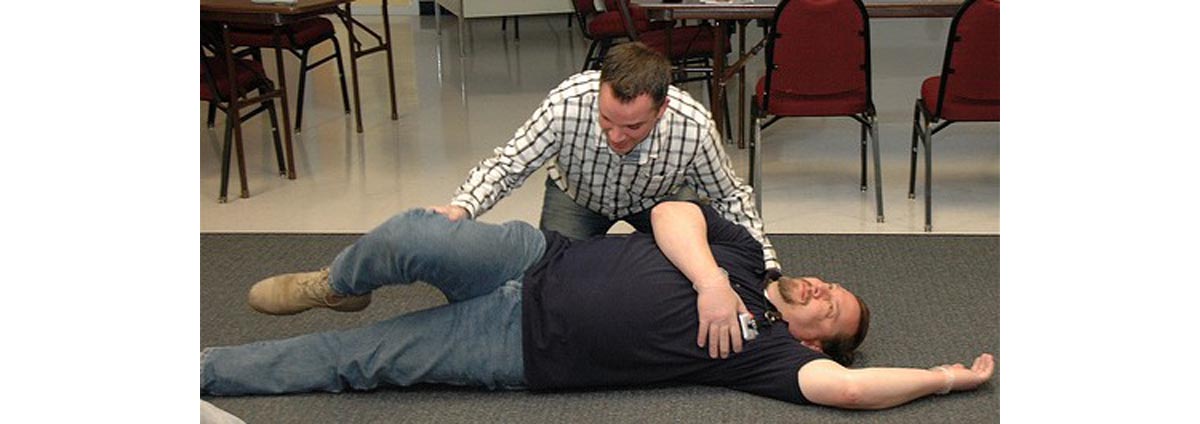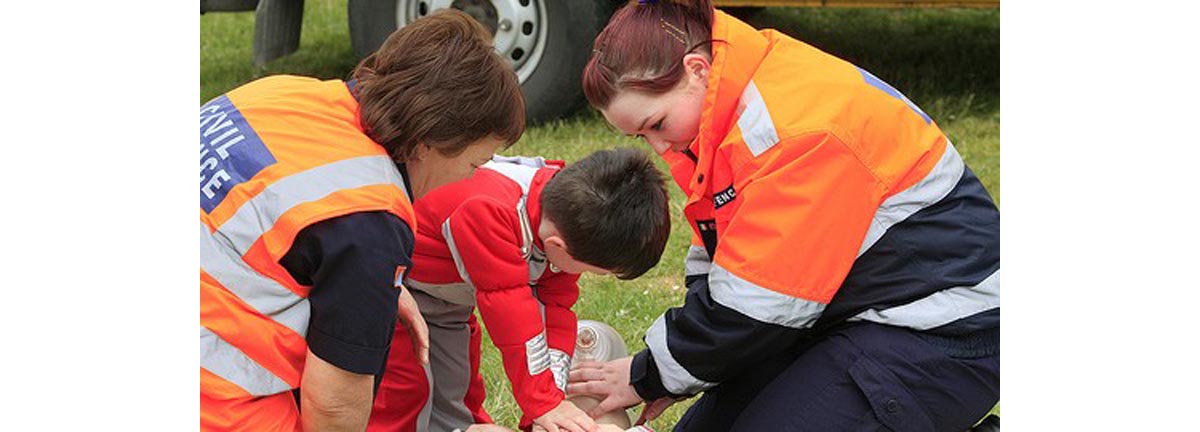Dr. Alson Inaba, a professor of pediatric medicine at the University of Hawaii, is one of the unsung heroes of the American healthcare sector. It was Dr. Inaba, flying home to Hawaii from a conference on heart health, who first realized that giving cardiopulmonary resuscitation to the beat of the Bee Gee's song Stayin' Alive was the perfect way for first responders, EMTs, and trained bystanders to give first aid to victims of cardiac arrest. Soon, even untrained laypeople were able to do it.

This popular song from the 1970's has a rhythm of 103 beats per minute. The American Heart Association recommends that manual chest compressions for sudden death victims should be given at 100 beats per minute.
Humming this Bee Gees hit gives away the right rhythm for saving lives — and the new method of CPR dos not require any icky mouth-to-mouth contact that bystanders may be afraid of. But to understand what the Bee Gees, chest compressions, and mouth-to-mouth resuscitation have to do with saving lives, it is probably helpful first to understand what was wrong with the old CPR techniques and to learn exactly what's new about the new way of doing CPR.
What Was Wrong with the Old CPR Techniques?
Most of us have seen demonstrations of the older method of giving cardiopulmonary resuscitation to people who are not breathing at all or who are only breathing with "agonal," gasping breaths — people who look like they might be dying, in other words. First, the person who gives emergency aid makes sure that the victim's breathing passages are open. Airways have to be clear for victims to have any chance of breathing on their own.
Then, in the old method of CPR, the first responder presses down on the victim's chest to a depth of 5 cm (about 2 inches) a total of 5 times, pinches the victim's nose shut, and breathes into the victim's mouth. Then the process is repeated, 5 compressions, one breath, 5 compressions, one breath, until the person is able to reach a hospital, often in an ambulance.
The problem with the old method to perform CPR was, despite what you may have seen on television or in the movies, it almost never worked. Fewer than two percent of people who suffered "sudden death" from irregular heart rhythms and received CPR outside the hospital could be brought back to life. (The figure is substantially higher for people who stop breathing because of drowning.) And up to 2/3 of that two percent of people who lived suffered permanent disability due to brain damage.
What's New About the New CPR?
Since 2005, both the American Red Cross and the American Heart Association have been recommending a different way of doing CPR. The new method of performing CPR relies on chest compressions alone. Instead of a relatively deep compression once a second, the new CPR requires a shallow compression, only to a depth of 2 cm (about 1 inch), but 100 times a minute instead of 60. And in the new CPR, no mouth-to-mouth resuscitation is required.
Emergency medical specialists realized that when CPR is used to keep patients alive in an emergency, it is usually because a bystander observed sudden death or risk thereof. In the one to two minutes after the heart suddenly stops, the blood still continues to carry oxygen, which means the person can still potentially be saved. It is more important to keep that oxygen-rich blood circulating than it is to stop to try to force more air into the lungs. And if the givers of emergency aid, whether first responders or untrained laypeople, can keep up the muscle compressions — a process that becomes very tiring very quickly for the first responder — in far more cases the victim can be kept alive long enough to get medical intervention, such as oxygen, intubation, and electrical shock to defibrillate and restart the heart. Some of these interventions require hospitalization, while others can be started right in the ambulance.
This new method of CPR brings the save rate for people who suffer sudden death outside the hospital to about 10%. But in the hospital, or when the ambulance comes very quickly, the rate of survival jumps to about 70%.
Everyone should learn how to give the new CPR. There is almost no risk of catching a disease by giving the new CPR. You won't have your mouth on their mouth when they start gasping for air (if CPR is successful). There are certain other unpleasant events that may happen, but won't happen into your mouth. And the new CPR is very easy to learn.
How To Do The New CPR
You can watch videos (links are below), take classes, or listen to instructions from a 911 (emergency) operator, but you can learn the basics of the new CPR right now, in just a few minutes.

Suppose you see someone fall down in front of you, no longer breathing.
Here is what you need to do.
- First, determine whether the victim is in a faint, or in a cardiac arrest. This is something you have to know very quickly. Kick them on the feet, shake their shoulders, and see if they can be roused. If they don't respond, and they aren't breathing, ask someone near you to call 911 (or the emergency number in your country), and if you are the only person with them, you call 911.
- Next, start CPR. Make sure the person you are helping is lying flat on their back on the floor. Then kneel down and lean over them, placing your right hand directly over their sternum, the breastbone. You don't have find any exact spot on the chest, but keep your hand in the middle of the chest as much as possible. Then weave the fingers of your left hand between the fingers of your right hand and start pressing at 100 times per minute. If you know the song Stayin' Alive, just do compressions to the beat. If you don't know Stayin' Alive, then give CPR to the beat of Row, Row Your Boat.
- Don't worry about cracking ribs. If you don't give CPR, the person is already dead. It isn't easy to cause injury in most people, but taking a CPR class with practice dummies will give you a feel for the right pressure to use in emergency situations.
That's all you have to do, but you have to keep doing it until help comes. It's hard work, but you have to keep it up until help comes, or until they start breathing on their own. Don't try to talk to an emergency response or rescue operator on the phone and give CPR at the same time. Just give them the address, explain what is happening, and get to work.
When CPR works, the victim starts breathing agonally, with a gasp. It is extremely unpleasant to breathe this way, and the victim may want to give up. If breathing resumes, try to talk to the victim to encourage them to stay awake (encouraging circulation to the brain) and to keep breathing. If breathing stops, start CPR again.
Give CPR before you use an automatic electronic defibrillator (AED). Often the pulse simply is undetectable. The automatic defibrillator won't give a shock unless it is needed, but oxygen in the bloodstream is essential before the heart is restarted.
Once you start CPR, don't quit. In most cases outside of the hospital, CPR only preserves life long enough for treatment with the automatic electronic defibrillator brought by the emergency response team, which brings heart rhythm and breathing back to normal.
Medical studies have shown that deaths occur when first responders switch with partners. Find the strength to keep on giving cardiopulmonary resuscitation in the knowledge that there is about a 50% chance that not only will the person you are giving aid live, but live with their mental faculties, their personality, and their memories intact. By giving the victim of sudden death the new CPR, you are giving them their only chance at survival, and you are giving them a 3500% better chance of survival than they could receive from the old method.
- Herlitz J, Svensson L, Holmberg S, Angquist K, Young M. Efficacy of bystander CPR: Intervention by lay people and by health care professionals. Resuscitation. 2005. 66:291–295. doi: 10.1016/j.resuscitation.2005.04.003.
- Trowbridge C, Parekh JN, Ricard MD, Potts J, Patrickson WC, Cason CL. A randomized cross-over study of the quality of cardiopulmonary resuscitation among females performing 30:2 and hands-only cardiopulmonary resuscitation. BMC Nurs. 2009 Jul 7. 8:6. doi: 10.1186/1472-6955-8-6.
- Photo courtesy of ozarksredcross on Flickr: www.flickr.com/photos/ozarksredcross/4352081361
- Photo courtesy of leppre on Flickr: www.flickr.com/photos/leppre/2502570443


Your thoughts on this